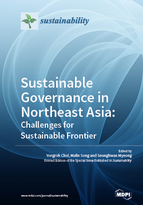Sustainable Governance in Northeast Asia: Challenges for Sustainable Frontier
A special issue of Sustainability (ISSN 2071-1050). This special issue belongs to the section "Economic and Business Aspects of Sustainability".
Deadline for manuscript submissions: closed (30 November 2016) | Viewed by 86534
Special Issue Editors
Interests: energy & environment (E&E); e-Business
Special Issues, Collections and Topics in MDPI journals
Interests: sustainable development; environmental economics
Special Issues, Collections and Topics in MDPI journals
Interests: smart cities; smart e-governance; digital divide; information management in public organizations; government innovation and project management; information technology and communication policy; research methodology
Special Issues, Collections and Topics in MDPI journals
Special Issue Information
Dear Colleagues,
This Special Issue will consist of selected papers from the Sustainable Asia Conference 2016 annual international conference held in Jeju Island, South Korea, 28 June through 2 July. SAC 2016 is one of the leading international conferences for presenting novel and fundamental advances in Sustainable Development Issues for Asia. The purpose of the conference is for scientists, scholars, engineers, and students from universities and research institutes around the world to present ongoing research activities so as to promote global research networking in the area of sustainable development. This conference provides opportunities for the delegates to exchange new ideas and application experiences, face-to-face, to establish research or business relations, and to find global partners for future collaborations. The scope of this Special Issue encompasses topics related to sustainable development and management at both the macro- and micro-levels in Northeast Asian countries.
Prof. Dr. Yongrok Choi
Dr. Malin Song
Prof. Dr. Seunghwan Myeong
Guest Editors
Manuscript Submission Information
Manuscripts should be submitted online at www.mdpi.com by registering and logging in to this website. Once you are registered, click here to go to the submission form. Manuscripts can be submitted until the deadline. All submissions that pass pre-check are peer-reviewed. Accepted papers will be published continuously in the journal (as soon as accepted) and will be listed together on the special issue website. Research articles, review articles as well as short communications are invited. For planned papers, a title and short abstract (about 100 words) can be sent to the Editorial Office for announcement on this website.
Submitted manuscripts should not have been published previously, nor be under consideration for publication elsewhere (except conference proceedings papers). All manuscripts are thoroughly refereed through a single-blind peer-review process. A guide for authors and other relevant information for submission of manuscripts is available on the Instructions for Authors page. Sustainability is an international peer-reviewed open access semimonthly journal published by MDPI.
Please visit the Instructions for Authors page before submitting a manuscript. The Article Processing Charge (APC) for publication in this open access journal is 2400 CHF (Swiss Francs). Submitted papers should be well formatted and use good English. Authors may use MDPI's English editing service prior to publication or during author revisions.
Keywords
- New theoretical modeling for sustainable governance in Northeast Asia
- Innovative case studies for sustainable governance with the unique contents of Northeast Asian countries (cultural, historical, socio-economical regime)
- International cooperation for the sustainable development or green growth
- Other related issues on the sustainable governance.








